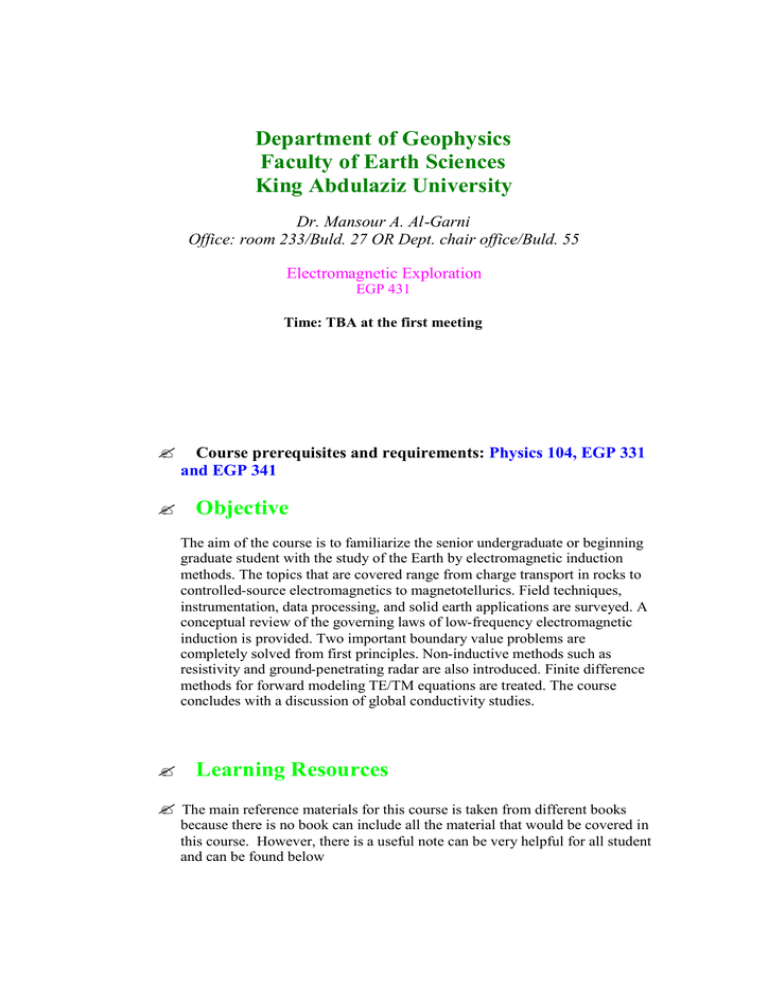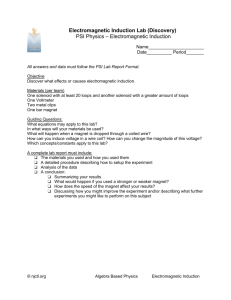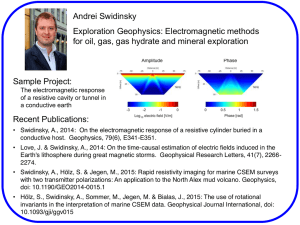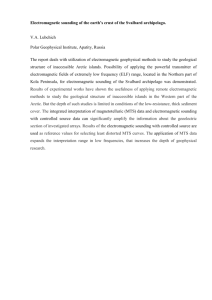EGP 431
advertisement

Department of Geophysics Faculty of Earth Sciences King Abdulaziz University Dr. Mansour A. Al-Garni Office: room 233/Buld. 27 OR Dept. chair office/Buld. 55 Electromagnetic Exploration EGP 431 Time: TBA at the first meeting Course prerequisites and requirements: Physics 104, EGP 331 and EGP 341 Objective The aim of the course is to familiarize the senior undergraduate or beginning graduate student with the study of the Earth by electromagnetic induction methods. The topics that are covered range from charge transport in rocks to controlled-source electromagnetics to magnetotellurics. Field techniques, instrumentation, data processing, and solid earth applications are surveyed. A conceptual review of the governing laws of low-frequency electromagnetic induction is provided. Two important boundary value problems are completely solved from first principles. Non-inductive methods such as resistivity and ground-penetrating radar are also introduced. Finite difference methods for forward modeling TE/TM equations are treated. The course concludes with a discussion of global conductivity studies. Learning Resources The main reference materials for this course is taken from different books because there is no book can include all the material that would be covered in this course. However, there is a useful note can be very helpful for all student and can be found below http://www.eudem.info http://www.geophysik.unikoeln.de/studium/WS04/vorlesung/env_geoscience/chapter3.pdf ......... available, please click here to download! Homework: Course Content (Lectures): If it is not http://geoweb.tamu.edu/Faculty/Everett/ 1. Introduction: electrical structure of the crust and mantle 1. Trends in the global electrical conductivity distribution 2. Regional geological interpretations based on electrical structure 2. Electrical conduction in rocks 1. Charge transport and polarization 2. Conduction in insulators, semiconductors, metals and electrolytes 3. Archie's law and porosity 4. Hashin-Shtrikman bounds 5. Example: clay minerals 6. Example: mantle olivine 3. Basic electromagnetic theory 1. Vectors: 1. Addition, scalar and cross products 2. Gradient of a scalar 3. Line integral, curl 4. Surface integral, divergence 5. Volume integral 6. Boundary conditions on normal components 7. Boundary conditions on tangential components 2. Ampere's law 3. Faraday's law 4. Electromagnetic diffusion vs. wave propagation 5. Source currents, eddy currents 6. Vector diffusion equations: 1. Time domain 2. Frequency domain 7. Electromagnetic induction in a halfspace due to plane wave excitation 1. Dirac delta functions 2. Surface currents 3. Symmetry considerations 4. Solving the boundary value problem 5. Skin depth 4. Controlled-source electromagnetics: large horizontal loop over a halfspace 1. 2. 3. 4. 5. 6. 7. 8. 9. Cylindrical coordinates Symmetry considerations Multidimensional Dirac delta functions Hankel transforms The primary field in free space: 1. Fourier transform approach 2. Green function approach Solving the boundary value problem Central-loop configuration, frequency response Laplace transforms Central-loop configuration, step-off transient response 5. Non-inductive methods 1. The resistivity method 2. Ground-penetrating radar 6. Principles of instrumentation 1. Sources: 1. Insulated loops, inductive coupling 2. Grounded wires, direct coupling 2. Receivers: induction coils, magnetometers, grounded wires 3. Sources of error in EM sounding data 4. Survey design considerations 7. Magnetotellurics 1. The natural geomagnetic spectrum 1. Magnetosphere and ionosphere, solar wind 2. Micropulsations and magnetospheric processes 3. Sferics, earth-ionospheric waveguide, Schumann resonances 4. Power lines, VLF transmitters 2. Impedance tensor, magnetic transfer function 3. Response function estimation: 1. Least-squares 2. Robust processing 4. TE and TM plane wave polarization 5. Apparent resistivity 8. Modeling 1. TE and TM mode scalar equations 2. Qualitative description of TE/TM apparent resistivity: 1. Vertical contact 2. Resistive dike 3. Conductive dike 3. Physics of electromagnetic induction in a buried plate 4. Finite difference methods: introduction 9. Global conductivity studies Cool Links: EM Wave Propagation http://www.phy.ntnu.edu.tw/ntnujava/viewtopic.php?t=52 http://www.ee.iastate.edu/~hsiu/em_movies.html http://www.amanogawa.com/archive/PlaneWave/PlaneWave-2.html http://www.walter-fendt.de/ph11e/emwave.htm http://appliedgeophysics.berkeley.edu:7057/ http://www.eos.ubc.ca/research/ubcgif/tutorials/index.html http://hydrate.eas.gatech.edu/eas4420/eas4420.em.html Course Content (Labs.): Lab. # Exp/Practical title 1 Introduction 2 Alternating Field Fundamental 3 4 General EM induction Skin depth, time constant, response parameter, wave length, velocity and dispersion, near, intermediate and far zone Reading Assignment What is Due? Chapter 2 page 4-5 Assignment 1 Physics Assignment 2 Chapter 2 page 29-32 Assignment 3 5 6 Velocity of smoke ring, diffusion distance, early, intermediate and late stages EM induction in prospecting, Frequency and Time domain methods Chapter 2 page 33-36 Assignment 4 Chapter 2 page 13-22 7 Sounding & Profiling Chapter 2 page 39-41 Assignment 5 8 Thickness, overburden and host rock effect, Noise and prospecting philosophy Chapter 2 page 42-49 Assignment 6 9 Mid - Exam Controlled source profiling 10 Moving source- moving receiver system, horizontal loop (FDEM) Chapter 3 page 56-62 Assignment 7 11 Vertical loop (FDEM) Chapter 3 page 68-74 Assignment 8 12 Horizontal loop (TDEM) Chapter 3 page 83-87 Assignment 9 13 Very low frequency (VLF) Chapter 3 page 83-87 Assignment 10 Chapter 4 page 159-167 Assignment 11 Chapter 4 page 170- Assignment 12 Controlled source sounding 14 Frequency sounding 15 16 Transient Sounding Final - Exam Laboratory Exercises: Some of the Laboratory exercises for this course can be found here Course Grading: Quiz and Homework Exam. #1 Exam. #2 Term paper (written and presentation) Laboratory Final Exam. TOTAL 10 % 10% 10% 10% 30% 30% 100% References: 1. Wangsness, RK 1979. Electromagnetic Fields, John Wiley & Sons. 2. Nabighian, MN 1991. Electromagnetic Methods in Applied Geophysics Vols.1-2, Society of Exploration Geophysics. 3. Richard Feynman 1964. Lecture on Physics, Volume II. 4. Alexander A. Kaufman, 1994. Geophysical Field Theory and Method, Part B. 5. Grant & West, 1965. Interpretation Theory in Applied Geophysics. 6. Selected articles from the geophysical literature. Remarks: STUDENTS ARE MOST WELCOME AND ENCOURAGED TO ASK QUESTIONS AS I GO THROUGH EACH LECTURE ATTENDANCE FOR THE FULL DURATION OF ALL LECTURES SESSIONS IS BOTH EXPECTED AND REQUIRED IT IS PREFERABLE THAT YOU READ THE MATERIAL THAT WOULD BE GIVEN IN THE LECTURE NEXT DAY. SHORT QUIZZES ARE GIVEN TO TEST YOUR KNOWLEDGE ABOUT THE MATERIAL THAT YOU ALREADY TOOK. ACADEMIC HONESTY IS VERY IMPORTANT. ANY FORM OF ACADEMIC DISHONESTY WILL RESULT IN A ZERO FOR THAT ASSIGNMENT: QUIZ, EXAM, HOMEWORK, ETC. AS WELL AS A POSSIBLE DISCIPLINARY ACTION. SEE YOUR STUDENT HANDBOOK FOR GUIDELINES.





